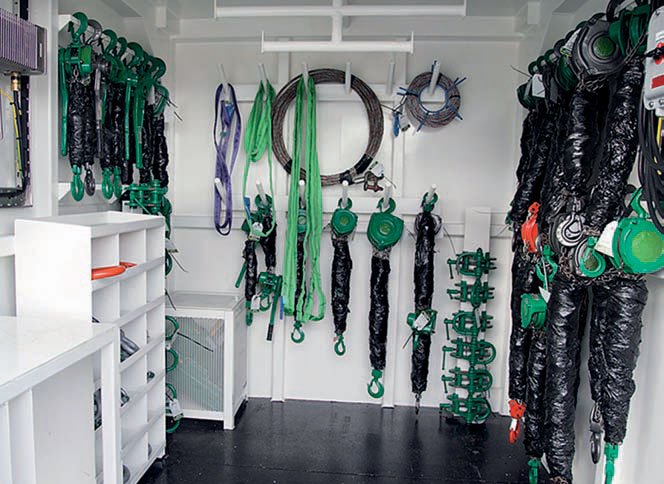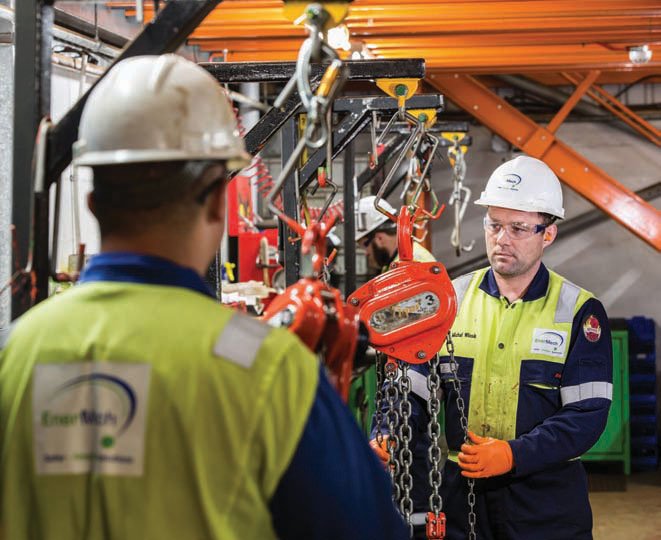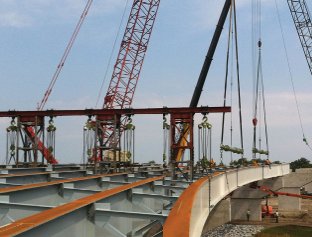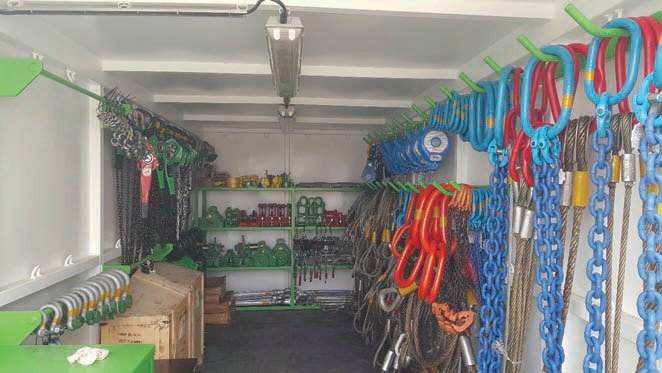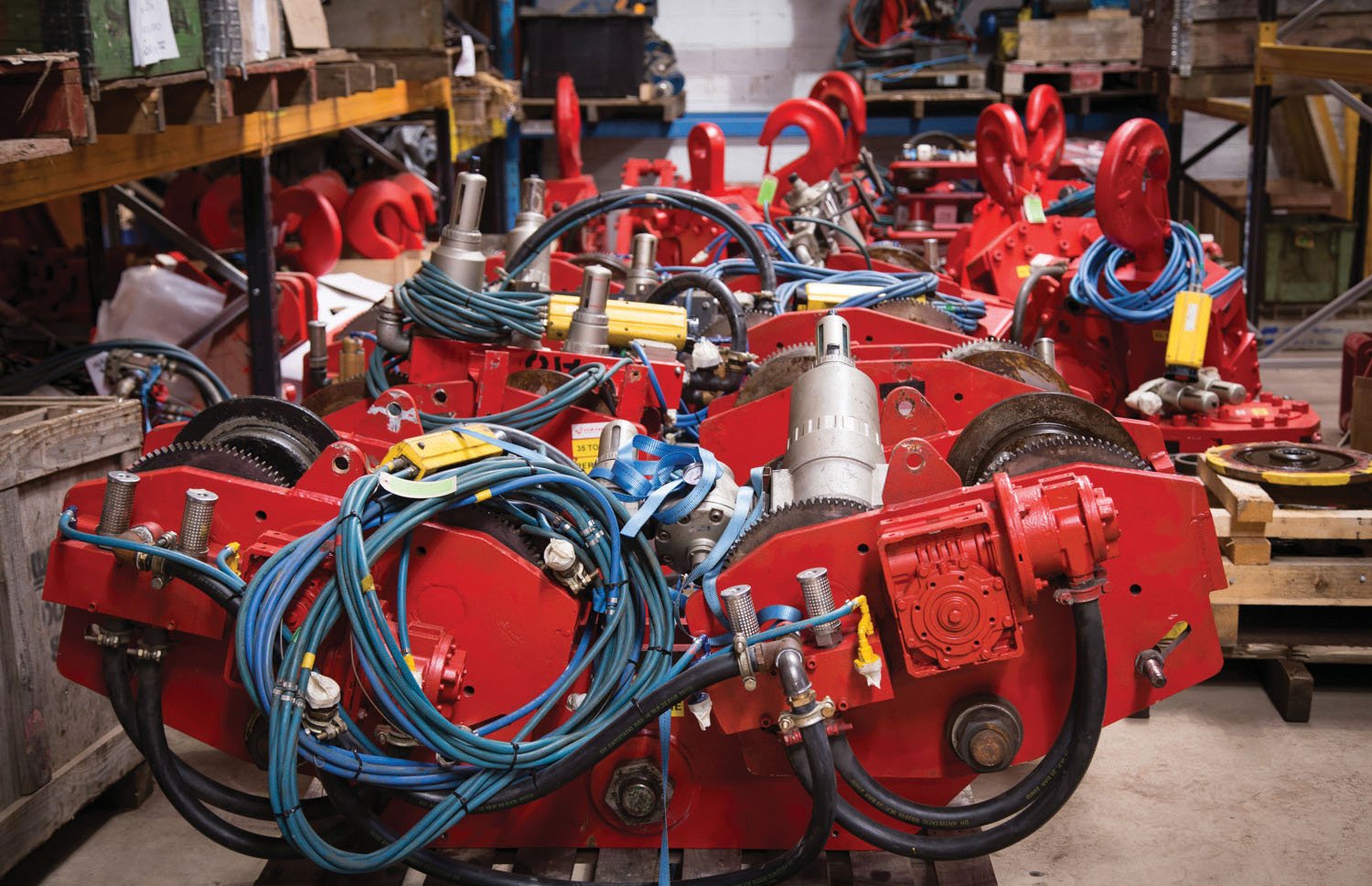Call the hire Brigade
25 April 2017For some industries, particularly the offshore oil and gas sector, renting lifting equipment is preferable to buying it. Sally Spencer reports.
There are many walks of life where renting rather than purchasing outright is preferable. This is certainly the case for some hoist and rigging loft users, for whom convenience, cost-effectiveness and the opportunity to leave the responsibility for inspections at the owner’s door are compelling reasons to hire rather than buy. Lifting Gear Hire (LGH) is a global player in rental equipment and is currently relaunching its UK business, following a 10- year hiatus after being bought by Speedy Hire and focusing its attention in the US and Europe.
LGH UK managing director Colin Naylor says the company rents out loose and packaged rigging equipment and also rigging lofts, from 10ft to 40ft. The equipment contained in the lofts is broadly similar but with some job-specific items.
“Whether we are mobilising a rigging loft for a hospital in central London, the overhaul of a chemical plant in Grangemouth or the support of a maintenance programme on an offshore oil platform, in essence the product mix is similar,” says Naylor. “It comprises clamping or trolleying equipment with hoists suspended from clamps and trolleys, and then lifting tackle in the form of slings and shackles and connection devices to the product or components that are being lifted, hoisted or rigged.”
“Obvious contents are base lifting items such as chain blocks, lever hoists, beam clamps and their associated components,” adds Walter Service, business manager for lifting and tooling at the Sparrows Group. “The loft is a maintenance store for the duration of its rotation so any piece of equipment regularly utilised with lifting equipment can be incorporated,” he says. “This might include flange lifting devices, rescue equipment or work at height plant.” While the basic contents might be similar, rigging lofts are also equipped to suit the environment they are deployed into.
“Rigging lofts go onto different work sites and into different industries,” says Mike Duncan, managing director of the Gaylin/Rigmarine group of companies. “For example, they are adopted for the oil and gas industries but even there you’ve got different environments—the offshore environment, the construction yard environment, the refinery environment. Generally it is all lifting and fall arrest equipment but they are tailored to suit the environment they are intended for. We even include power and hand tools if the client so requires.”
Gaylin/Rigmarine rents out 10ft, 20ft and 40ft containers but says the larger size of the latter made it more unusual. EnerMech’s rigging lofts are typically 10ft x 8ft and 20ft x 8ft and layout is flexible, depending on the client’s requirements.
The lofts can be provided with hang-off racks to suspend hoists and equipment from, shelving for storage and a workbench with storage cupboard and vice. They are also fitted with “Ex” rated lighting and heating systems as standard. Rental periods vary across the sector and petrochemical plants tend to rent for the shortest period according to Naylor at LGH.
“Rigging lofts are usually rented for five or six weeks while part of a petrochem process is shut down for an intensive overhaul,” he says. “We’ll often quote a fixed price for that period of time and if the overhaul is finished early we’ll issue credit and if it’s late we’ll agree a pro-rata weekly charge thereafter.
“A rigging loft on a construction site will generally stay out for as long as building and fit-out is ongoing, in some instances for more than 12 months, so we would agree a monthly or weekly hire rate.”
That is also the case in offshore applications, where rigging lofts are sent out for the overhaul and maintenance of rigs. Here the hire period can be many months, if not years, largely impacted by the high cost of mobilisation to and from the offshore platforms.
Long duration rentals on offshore platforms or onshore projects require sixmonthly rotations because of mandatory inspection and certification processes. These rotations will include provision for an overlap period, to ensure smooth transition of equipment.
“There are short-term, single usage rentals where a project might only last three or four months, but there are a lot of projects, certainly in the North Sea and other offshore locations globally where the deal will be for up to five years,” says Duncan.
Finding and re-certifying all the lifting equipment to comply with LOLER inspection protocols is no small task on an oil rig, so the rigging lofts are “repeated” on a six-monthly basis.
“In the case of an offshore rigging loft, another rigging loft, re-certified with duplicate equipment, will be sent out on the fifth month,” says Duncan. “This new loft will have a different colour code and they’ll start using it straight away. Over the following few days they will gather the contents of the previous loft and ship it to shore, where it will undergo its six-monthly certification.”
EnerMech also operates a colour coding system.
“Colour coding of equipment highlights to the end users that it is within certification for a six month period, changing the colour for the next rotation,” says Sarah Macklin, EnerMech’s equipment, lifting and inspection manager.
“The lofts are also provided with a T-Card system to assist with booking the equipment in and out of the lofts.
“We are currently reviewing the concept of introducing ‘Smart Loft’ where the equipment is fitted with electronic tags that will automatically record the equipment leaving and entering the lofts.”
Sparrows says its lofts contain a full register of equipment, including copies of current reports of thorough examination— under LOLER—movement tracking guidance and information on safe use of products within the loft.
“We have recently introduced remote frequency identification (RFID) tagging, which is a more efficient and advanced method of tracking equipment than using traditional T-cards,” says Service. “Use of RFID supports quicker inventory checks, full rotation of equipment and reduces non-compliance of equipment.”
All the hire companies cite inventory management as the primary benefit of renting rather than buying equipment. “To enable six-monthly rotation, clients would have to hold two lots of plant and to control statutory periodic examination of equipment to ensure suitability for use when required,” says Service.
“This carries a heavy burden in terms of administrative and operational expense and leaves inventory stretched when flexibility is required for specific work scopes or shutdown needs,” he continues. “Loft rental ensures the necessary product is received on board when required, fully certified to the appropriate standard and properly colour coded for the new rotation with minimal upheaval to offshore routines. “After the rigging loft is returned to us at the end of a rotation, all equipment goes through a full strip down of every component that includes cleaning, blasting and repainting before it is re-certified.”
EnerMech agrees that renting reduces costs by eliminating the need for maintenance and repair parts, for storage areas, equipment utilisation and for personnel to manage both the rigging equipment and the documentation. It also provides flexibility with equipment requirements.
“Additional benefits are access to our equipment experts, 24/7 support service to accommodate our client’s needs after hours and EnerMech Live,” says Macklin. “EnerMech Live is a web-based system that can be remotely accessed by our clients to download copies of certification, equipment listings and their current location, safe use and handling instructions and online procurement,” adds Macklin.
Duncan at Gaylin/Rigmarine adds that the fact that the onus of certification was on the supplier of the loft rather than the contractor reduced downtime on site and brought capital expenditure down.
“Many contractors are only on a year’s contract so the last thing they want to do is procure all this equipment and then have it all lying about waiting to be disposed of at the end of the project,” he says.
The offshore oil and gas, petrochemical and construction sectors dominate demand for rigging loft hire but LGH’s Naylor says virtually any other sector could benefit, particularly if the location is remote or the logistics are challenging. “If a big ship comes into a dockyard for an overhaul they will often put a small rigging loft in and that way reduce the volume of traffic and the cost of deliveries and collections,” says Naylor.
Power generation sector engineers working on overhead power cables in remote and inaccessible areas will also hire containers with perhaps 30 pieces of rigging equipment, enough to cover all eventualities, Naylor adds.
Gaylin/Rigmarine’s Mike Duncan agreed that space constraints on ships or barges make rigging lofts an appropriate choice and adds that there was increasing demand from the renewables sector— hydropower and offshore and onshore wind farms.
That’s also the experience of Sparrows and EnerMech, who both cite shipbuilding, heavy construction and renewable energy sectors as suitable candidates.
Rental companies offer services in addition to the simple equipment and container hire. Advice on the specific rigging equipment to be supplied in the loft is offered, for example.
“Quite often a client will see the need for a rigging loft but won’t know exactly what equipment they need, so they will describe the scope of works to us and we will recommend the appropriate rigging,” says Duncan.
He adds that the Rigmarine part of the business has a training department and much of the tuition it provides is for rigging loft management. The three-day course includes instruction on the legislation surrounding lifting equipment and where the responsibilities lie.
“We are living in a world where proof of competency is a very big thing, especially in the offshore sector,” says Duncan.
“It is certainly very difficult to prove competency in an individual but having documented training and subsequent assessments on file is a great starting block.”
Colin Naylor says LGH offers advice on rigging activity and is occasionally asked to help customers with their rigging assessments and statements.
There are other opportunities to “add value” to the customer’s requirements, he says, including selling “consumable” items to complement the rigging equipment.
“This includes safety harnesses and PPE such as goggles, gloves and high-vis,” says Naylor. “It can also include lifting tackle such as small slings and shackles that are generally purchased these days rather than rented because the likelihood is that they will be lost or damaged during the work. It can be more economical for the customer to use them and bin them at the end of the job rather than maintain them.”
Sparrows also offers sales, design and lift planning in conjunction with rentals and says it reported on equipment condition after each rotation to ensure equipment suitability and volume is maintained. “We also undertake SI 2307 examination and reporting of fixed platform equipment to allow control of both rental and client owned equipment and, where required, offer guidance on product use,” says Service.
EnerMech’s many additional services include onshore and offshore equipment service, repair, testing and re-certification and maintenance and management of client-owned equipment. It also offers installation and commissioning and “equipment familiarisation.”
HOISTS FOR HIRE
There is also a keen rental market for hoists, although unlike rigging loft hire, demand usually stems from single projects. What they do have in common is cost efficiency and convenience.
“Most applications are different—one might require two tonnes to be moved at six metres height and the next might be three tonnes at nine metres and so on,” says LGH’s Naylor. “Generally a much wider range is attainable by hiring equipment rather than a single purchase of one unit.”
Service at Sparrows agees: “A client’s needs may involve a range of lifts over a short period, so ownership would be onerous. Rental allows the client to obtain specific task hoists at a fixed price and with certification guaranteed to statutory compliance.”
Adrian Saward, sales and business development manager at Red Rooster Lifting adds that when a project calls for a lifting application for only a short duration, the cost of purchasing new far outweighs the cost of hiring equipment—although there is the option to purchase during the hire.
He adds that availability of ‘ready to go’ equipment was also an incentive to hire. “All Red Rooster hoists are fully serviced after a hire—regardless of the duration— prepared again to match the requirement of the next hire, on demand, and delivered fully certified.”
Rental periods vary, with some companies offering “anything from six days to six months”—which can be extended if the hoists and winches are maintained and recertified on site—while others, such as Red Rooster have a minimum hire period of two weeks.
“The length of hire is normally dictated by the project and also the location,” says Saward. “However, because of the cost of preparation the minimum hire period is normally two weeks.”
As mentioned, rental companies offer a wide range of hoists and hold impressive stocks.
Sparrows, for example, has a plant fleet of 14,000 items, with hoists up to 20t capacity. Equipment includes chain blocks, lever hoists, beam clamps, beam trolleys, rope pullers, air hoists, snatch blocks, inertia reels and jacks.
EnerMech has more than 100 hoists and winches and its rental offering includes pneumatic hoists from 250kgs to 50t. These can be hired in various configurations—for example, trolley mounted in standard, low and ultra-low headroom, with the most popular being hook suspension.
The company also offers a range of pneumatic winches from 250kgs to 10t, including man-riding. These can be provided with specified rope types and length, base plates/frames and local or pendant controls.
Red Rooster offers load cells, air winches and Kito manual chain blocks— with capacities of 15-50t—but says the biggest part of its 400-plus hire fleet is made up of Red Rooster air hoists.
“These can be supplied as ATEX Zone 2 or Zone 1 upon request and configured as a hook suspension, or supplied as a hoist and trolley combination with low headroom also available,” says Saward. LGH UK’s portfolio includes manual chain and lever hoists and Tirfor machines, along with air chain hoists, electric chain hoists and various wire rope hoists— including Minifor and Tirak.
“In terms of lifting gear it is quite a broad range,” says Naylor. “We’re focused on probably the top third of products used in the lifting spectrum and we are going heavily into that in terms of capacity and quantity.
“Within our group we have air hoists up to 100 tonnes on a single unit and stock close on 5,000 air hoists worldwide—and of that 99% are JD Neuhaus. In the UK we have more than 250 units.”
LGH’s electric hoists are offered in a range up to 20t.
There is no obvious trend in the type of hoists being hired, says suppliers, hence the broad range stocked by them.
“Demand is strong across the board but some sectors are looking for higher tonnage, higher capacity hoists,” says Naylor. “These are particularly aligned to offshore installation or decommissioning activities and to shipyards. Hoists are used to lift and turn propellers into position and as ships are getting bigger, propellers are getting bigger and so are the hoists.” As with rigging loft rental, hoist rental comes with add-ons, particularly in the form of advice.
“We often advise customers on the best product for the application,” says Naylor. “In some instances we have to lean heavily on the technical departments of the manufacturers to ascertain whether the hoist in question is appropriate for the lifting application and the load being applied.”
Saward adds: “Most of the time our clients are the contractor and are already familiar with Red Rooster hoists, so providing staff to oversee their use is not normally required. That says, we have been required to supervise and/or assist clients in the installation and use of our hoists for their projects, both on and offshore.”
He adds that the company can also assist with lift plans, specifications, training, inspections and maintenance. The offshore oil and gas sector has provided good business for hoist rental— as it has for rigging lofts—with demand also coming from renewable energy, heavy construction, processing plants and ship building.
